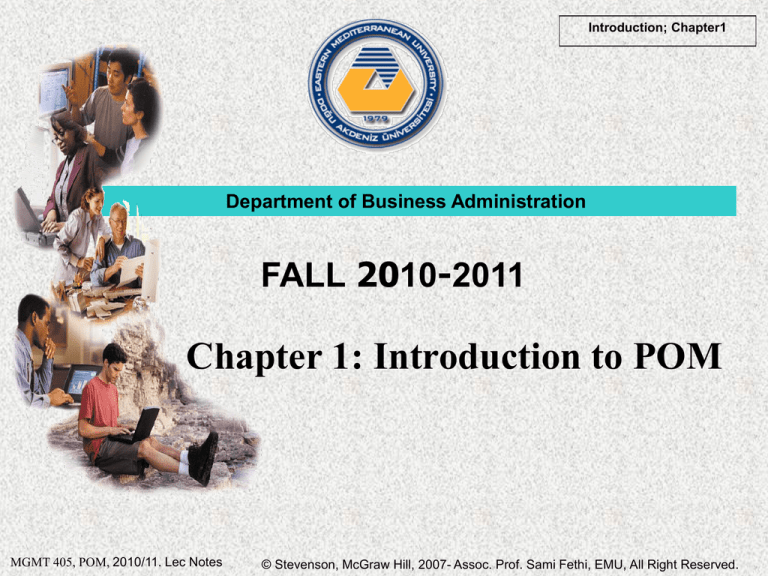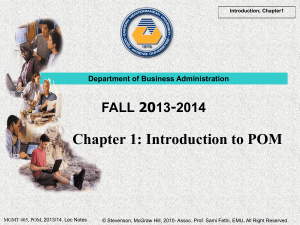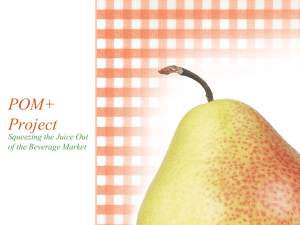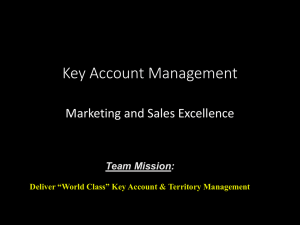
Introduction; Chapter1
Department of Business Administration
FALL 2010-2011
Chapter 1: Introduction to POM
MGMT 405, POM, 2010/11. Lec Notes
© Stevenson, McGraw Hill, 2007- Assoc. Prof. Sami Fethi, EMU, All Right Reserved.
Outline: What You Will Learn . . .
Introduction; Chapter1
Define the term operations management
Identify the three major functional areas of organizations and
describe how they interrelate
Compare and contrast service and manufacturing operations
Describe the operations function and the nature of the
operations manager’s job
Differentiate between design and operation of production
systems
Describe the key aspects of operations management decision
making
Briefly describe the historical evolution of operations
management
Identify current trends that impact operations management
2
MGMT 405, POM, 2010/11. Lec Notes
© Stevenson, McGraw Hill, 2007- Assoc. Prof. Sami Fethi, EMU, All Right Reserved.
Introduction; Chapter1
Definition of Operations Management
Production/Operations Management is:
The management of that part of an organization that is
responsible for producing goods and/or services.
The management of systems or processes that create
goods and/or provide services.
i.e. Every book you read, every e-mail you send or every medical treatment you
receive involves the operation function of one or more organizations.
The aim of production and operations is to satisfy
people’s wants or needs.
Operations Management affects:
The collective success or failure of companies’ POM
Companies’ ability to compete
Nation’s ability to compete internationally
MGMT 405, POM, 2010/11. Lec Notes
3
© Stevenson, McGraw Hill, 2007- Assoc. Prof. Sami Fethi, EMU, All Right Reserved.
Introduction; Chapter1
Business Organization
The Three Basic Functions
Fig 1.1
Finance
Organization
Operations
Marketing
All business organizations have these three basic functions so it doesn’t matter
the business a hospital, a manifacturing firm, a car wash etc.....
4
MGMT 405, POM, 2010/11. Lec Notes
© Stevenson, McGraw Hill, 2007- Assoc. Prof. Sami Fethi, EMU, All Right Reserved.
Introduction; Chapter1
Basic Concepts
Finance- is responsible for securing financial
resources at favourable prices as well as analysing
investment proposal and providing funds for
marketing and operations.
Marketing is responsible for assessing consumer
needs or wants and selling and promoting the
organization’s goods and services.
Operations is responsible for producing the goods or
providing the services offered by the organization.
5
MGMT 405, POM, 2010/11. Lec Notes
© Stevenson, McGraw Hill, 2007- Assoc. Prof. Sami Fethi, EMU, All Right Reserved.
Introduction; Chapter1
Value-Added Process
The operations function involves the conversion
of inputs into outputs
Value added
Inputs
Land
Labor
Capital
Transformation/
Conversion
process
Outputs
Goods
Services
Feedback
Control
Feedback
Feedback
Figure 1.2
6
MGMT 405, POM, 2010/11. Lec Notes
© Stevenson, McGraw Hill, 2007- Assoc. Prof. Sami Fethi, EMU, All Right Reserved.
Introduction; Chapter1
Basic Concepts
Input- Materials, labour, information, technology,
equipment, legal constraints, government regulations
etc....
What type of skill do the employees need?
What type of materials does the firm need?
Value-Added Activities- Performed with tools
machines, techniques, human skills etc....i.e.
Processing.
How will the firm use its resources to produce its products/
how can the firm improve its operations?
Output- Good and services.
what are their needs/what sort of products will be produced?
7
MGMT 405, POM, 2010/11. Lec Notes
© Stevenson, McGraw Hill, 2007- Assoc. Prof. Sami Fethi, EMU, All Right Reserved.
Introduction; Chapter1
Value-added
Value-added is the difference between the cost of inputs and
the value or price of outputs.
In non-profit organization, value-added of output is their
value to society.
The greater the value-added, the greater the effectiveness of
these operations (i.e. High way construction, state school
construction etc...).
In profit organization, value-added of output is measured by
prices that customers are willing to pay for those goods and
services.
Firms use the money generated by value-added for research
and development, worker salaries and profit.
The greater the value-added, The greater the amount of funds
available for these purposes.
8
MGMT 405, POM, 2010/11. Lec Notes
© Stevenson, McGraw Hill, 2007- Assoc. Prof. Sami Fethi, EMU, All Right Reserved.
Introduction; Chapter1
Is Goods-service combination a Continuum?
Goods
Service
Surgery, teaching
Song writing, software development
Computer repair, restaurant meal
Automobile Repair, fast food
Home remodeling, retail sales
Figure 1.3
Automobile assembly, steel making
9
MGMT 405, POM, 2010/11. Lec Notes
© Stevenson, McGraw Hill, 2007- Assoc. Prof. Sami Fethi, EMU, All Right Reserved.
Introduction; Chapter1
Why Product Packages?
Because there are relatively few pure goods and pure
services and therefore companies sell Product
packages for their own benefit or interest.
Product packages are a combination of goods and
services.
Product packages can make a company more
competitive.
10
MGMT 405, POM, 2010/11. Lec Notes
© Stevenson, McGraw Hill, 2007- Assoc. Prof. Sami Fethi, EMU, All Right Reserved.
Introduction; Chapter1
Example of the transformation for Food Processor
Inputs
Processing
Outputs
Raw Vegetables
Metal Sheets
Water
Energy
Labor
Building
Equipment
Cleaning
Making cans
Cutting
Cooking
Packing
Labeling
Canned
vegetables
Table 1.2
11
MGMT 405, POM, 2010/11. Lec Notes
© Stevenson, McGraw Hill, 2007- Assoc. Prof. Sami Fethi, EMU, All Right Reserved.
Introduction; Chapter1
Example of the transformation for Hospital Process
Inputs
Doctors, nurses
Hospital
Medical Supplies
Equipment
Laboratories
Processing
Outputs
Examination
Surgery
Monitoring
Medication
Therapy
Healthy
patients
Table 1.3
12
MGMT 405, POM, 2010/11. Lec Notes
© Stevenson, McGraw Hill, 2007- Assoc. Prof. Sami Fethi, EMU, All Right Reserved.
Introduction; Chapter1
Manufacturing or Service?
Tangible
Act
Manufacturing and Service are often different in terms of
what is done but quite similar in terms of how it is done.
For example, manufacturers decide what size factory needed
and service organizations must decide what size building is
needed.
Manufacturing and Service differ cause manufacturing is
goods-oriented and service is act-oriented.
13
MGMT 405, POM, 2010/11. Lec Notes
© Stevenson, McGraw Hill, 2007- Assoc. Prof. Sami Fethi, EMU, All Right Reserved.
Introduction; Chapter1
Production of Goods vs. Delivery of Services
Production of goods – tangible output
Delivery of services – an act
Service job categories
Government (state, local, etc..)
Wholesale/retail (clothing, food, stationery,etc..)
Financial services (banking, insurance, etc..)
Healthcare (doctors, dentists, hospitals, etc..)
Personal services (laundry, dry cleaning, etc..)
Business services ( data processing, e-business, etc..)
Education (schools, colleges, etc..)
14
MGMT 405, POM, 2010/11. Lec Notes
© Stevenson, McGraw Hill, 2007- Assoc. Prof. Sami Fethi, EMU, All Right Reserved.
Introduction; Chapter1
Key Differences between manufacturing and Service operations
1. Customer contact
2. Uniformity of input
3. Labor content of jobs
4. Uniformity of output
5. Measurement of productivity
6. Production and delivery
7. Quality assurance
8. Amount of inventory
9. Evaluation of work
10. Ability to patent design
15
MGMT 405, POM, 2010/11. Lec Notes
© Stevenson, McGraw Hill, 2007- Assoc. Prof. Sami Fethi, EMU, All Right Reserved.
Introduction; Chapter1
Goods vs. Service
Characteristic
Customer contact
Goods
Low
Service
High
Uniformity of input
Labor content
Uniformity of output
Output
High
Low
High
Tangible
Low
High
Low
Intangible
Measurement of productivity
Opportunity to correct problems
Inventory
Easy
High
Much
Difficult
Low
Little
Evaluation
Patentable
Easier
Usually
Difficult
Not usual
16
MGMT 405, POM, 2010/11. Lec Notes
© Stevenson, McGraw Hill, 2007- Assoc. Prof. Sami Fethi, EMU, All Right Reserved.
Introduction; Chapter1
Goods vs. Service
Percent
U.S. Manufacturing vs. Service Employment
02
Year
9045
8050
7055
6060
5065
4070
3075
2080
1085
090
95
45
00
Mfg.
Service
79
21
72
28
72
28
68
32
64
36
64
36
58
42
44
46
43
57
35
65
25
75
50 55 60 65
30
70
25
75
Mfg.
Service
70
75
80
85
90
95
00
02
05
Year
Figure 1.4
17
MGMT 405, POM, 2010/11. Lec Notes
© Stevenson, McGraw Hill, 2007- Assoc. Prof. Sami Fethi, EMU, All Right Reserved.
Introduction; Chapter1
Why Manufacturing Matters?
Over 18 million workers in manufacturing jobs
Accounts for over 70% of value of U.S. exports
Average full-time compensation about 20% higher
than average of all workers
Manufacturing workers more likely to have
benefits
Productivity growth in manufacturing in the last 5
years is more than double U.S. economy
18
MGMT 405, POM, 2010/11. Lec Notes
© Stevenson, McGraw Hill, 2007- Assoc. Prof. Sami Fethi, EMU, All Right Reserved.
Introduction; Chapter1
Why Manufacturing Matters?
More than half of the total R&D performed is in
the manufacturing industries
Manufacturing workers in California earn an
average of about $25,000 more a year than service
workers
When a California manufacturing job is lost, an
average of 2.5 service jobs are lost
19
MGMT 405, POM, 2010/11. Lec Notes
© Stevenson, McGraw Hill, 2007- Assoc. Prof. Sami Fethi, EMU, All Right Reserved.
Introduction; Chapter1
Challenges of Managing Services
Service jobs are often less structured than
manufacturing jobs
Customer contact is higher
Worker skill levels are lower
Services hire many low-skill, entry-level workers
Employee turnover is higher
Input variability is higher
Service performance can be affected by worker’s
personal factors
20
MGMT 405, POM, 2010/11. Lec Notes
© Stevenson, McGraw Hill, 2007- Assoc. Prof. Sami Fethi, EMU, All Right Reserved.
Introduction; Chapter1
Key Decisions of Operations Managers
What
What resources/what amounts
When
Needed/scheduled/ordered
Where
Work to be done
How
Designed
Who
To do the work
21
MGMT 405, POM, 2010/11. Lec Notes
© Stevenson, McGraw Hill, 2007- Assoc. Prof. Sami Fethi, EMU, All Right Reserved.
Introduction; Chapter1
Types of Operations
Operations
Examples
Goods Producing
Farming, mining, construction,
manufacturing, power generation
Storage/Transportation Warehousing, trucking, mail
service, moving, taxis, buses,
hotels, airlines
Exchange
Retailing, wholesaling, banking,
renting, leasing, library, loans
Entertainment
Films, radio and television,
concerts, recording
Communication
Newspapers, radio and television
newscasts, telephone, satellites
22
MGMT 405, POM, 2010/11. Lec Notes
© Stevenson, McGraw Hill, 2007- Assoc. Prof. Sami Fethi, EMU, All Right Reserved.
Introduction; Chapter1
Historical Evolution of Operations Management
System for P & O have existed since ancient times.
The great wall of China
Egyptian pyramids
i.e. More than 100000 workers for 20 years.
The ships of Roman empire
The roads and aqueducts of the Roman
These are all examples of the human ability to
organize for operation and production
These also show the roots of the Industrial
Revolution
23
MGMT 405, POM, 2010/11. Lec Notes
© Stevenson, McGraw Hill, 2007- Assoc. Prof. Sami Fethi, EMU, All Right Reserved.
Introduction; Chapter1
Historical Evolution of Operations Management
Industrial revolution (1770’s) in England
Scientific management (1911)
Mass production
Interchangeable parts
Division of labor
Human relations movement (1920-60)
A psychologist focusing on human factor in work-tiredness and motivation.
Decision models (Harris 1915-inventory model, 1960-70’s)
The factory movement was accompanied by the development of several
quantitative techniques. After ww II-the importance of military and
manifucturing sectors, the models of forecasting, inventory management,
project management were developed.
Influence of Japanese manufacturers
JIT production, quality revolution, continual improvement etc.
MGMT 405, POM, 2010/11. Lec Notes
24
© Stevenson, McGraw Hill, 2007- Assoc. Prof. Sami Fethi, EMU, All Right Reserved.
Introduction; Chapter1
The evolution of POM
Production of goods remained at a handicraft level untill the
Industrial revolution took place. In 1764 (1770s), the Industrial
revolution began and James Watt invented the steam engine and
advanced the use of mecanical power to increase productivity.
Eli Whitney (1798) found out and introduced the concepts of
standardised parts and interchangeable parts. He then
developed musket system because the type of muskets were
handcrafted-he produced 10000 muskets by using the concept
of interchangeable parts.
By using the same concept, he allowed the manifacture of firealarms, clocks, watchs, sewing machines etc..
Soon after, by conducting the concept of steam engine, Richard
Trevithick (1802) invented the first train and Richard Fulton
(1807) invented the first steam boat.
25
MGMT 405, POM, 2010/11. Lec Notes
© Stevenson, McGraw Hill, 2007- Assoc. Prof. Sami Fethi, EMU, All Right Reserved.
Introduction; Chapter1
The evolution of POM
The first steam boat and the first train indicate a long stream of
application in which human anad animal powers were replaced
by engine power.
The Industrial revolution was the transformation of a society
from peasant and local occupation into a society with world
wide connections in terms of great use of machinery and largescale commercial operations. This is the first step of factory
system.
This system replaced the traditional production system by the
concept of mass-production by bringing together large numbers
of semi-skilled workers.
Adam Smith’s ‘The wealth of nations’ (1776) pointed out the
importances and advantages of the division of labor where the
production process was broken down into series of small tasks
and each performed by a different worker.
MGMT 405, POM, 2010/11. Lec Notes
26
© Stevenson, McGraw Hill, 2007- Assoc. Prof. Sami Fethi, EMU, All Right Reserved.
Introduction; Chapter1
The evolution of POM
With aid of the concept of the division of labor:
Workers who continually perfomed the same task, they would
gain skill and experience.
Saving time or avoiding lost time due to changing jobs.
Workers’ concentration on the same job increased would lead to
the development of special tools and techniques for faster and
easier task.
Specialization jobs and division of labor began to take place. A
prominent mathematician and engineer Charles babbage (1832)
promoted an economic analysis of work and pay on the basis of
skill requirement.
In the earliest days of manufacturing, goods were produced using
craft production-highly skilled workers conducting simple,
flexible tools to produce small quantities customized goods .
27
MGMT 405, POM, 2010/11. Lec Notes
© Stevenson, McGraw Hill, 2007- Assoc. Prof. Sami Fethi, EMU, All Right Reserved.
The evolution of POM
Introduction; Chapter1
Frederick Taylor (1911) who is often referred to as the father of
scientific management, published ‘the priciples of scientific
management’. This helped to achieve wide tasks in industry.
Frank Gilber (principles of motion economy), Henry Gantt
(schudeling and charts design for system) and Herrington
Emerson (organizational efficiency) used Taylor’s ideas to
improve the system of operation and production management.
Influence of Japanese manufacturers
JIT production, quality revolution, continual improvement etc.
Using the concept of JIT production, Japanese manufacturers
changed the rules of production from Mass Production to Lean
Production.
Lean production prizes flexibility rather then efficiency, as well
as quality rather than quantity. This indicates the first step of
‘Era of Industrial globalization’.
MGMT 405, POM, 2010/11. Lec Notes
28
© Stevenson, McGraw Hill, 2007- Assoc. Prof. Sami Fethi, EMU, All Right Reserved.
Introduction; Chapter1
The evolution of POM
Figure 1.5
29
MGMT 405, POM, 2010/11. Lec Notes
© Stevenson, McGraw Hill, 2007- Assoc. Prof. Sami Fethi, EMU, All Right Reserved.
Introduction; Chapter1
School of Management
The process school of management
was developed by Henry Fayol in 1900
management can be viewed as a continuous process
the function of planning, organizing and controlling
The behavioural school of management
was developed by Elton Mayo in 1920
human relation movement on production output
Productivity depends not only on the physical
environment but also on social norms and personal
feelings (i.e. Western Electric’s Hawthorne plant)
30
MGMT 405, POM, 2010/11. Lec Notes
© Stevenson, McGraw Hill, 2007- Assoc. Prof. Sami Fethi, EMU, All Right Reserved.
Introduction; Chapter1
School of Management
The quantitative school of management
is concerned with decision making, mathematical
modeling as well as system theory
represents a productive system
In 1915, Harris developed an Economic Order
Quantity model for inventory management
In 1931, Shewhart developed a Quantity decision
model for use in Statistical quality control work
In 1947, George Dantzing developed PERT/CPM
In the late 1950s and early 1960s Edward Bowman,
Robert Fetter and Elwood Buffa developed the
concept called Modern poduction Management
As computers became available in the 1950s, the
power of opeartions research was multiplied
31
MGMT 405, POM, 2010/11. Lec Notes
© Stevenson, McGraw Hill, 2007- Assoc. Prof. Sami Fethi, EMU, All Right Reserved.
Introduction; Chapter1
School of Management
The School of Modern Management
In the late 1960s, MRP and CPR were introduced by Joseph
Orlicky and Oliver White
In the late 1970s, MRP II, JIT, TMQ and KANBAN
systems were developed
the School of Modern Management includes the system and
the contingency approaches.
these are also called new contemporary management
approaches
the system approach points out that an organization has
interdependent factors as such individuals, status, motives,
goals etc and must work together
the contingency approach reveals that organizations are
different so different and changing cases need to conduct
different approaches and techniques in reaching a solution
32
MGMT 405, POM, 2010/11. Lec Notes
© Stevenson, McGraw Hill, 2007- Assoc. Prof. Sami Fethi, EMU, All Right Reserved.
Introduction; Chapter1
Trends in Industrial Globalization
Major trends
The Internet, e-commerce, e-business
Management technology
Globalization
Management of supply chains
Outsourcing
Agility
Ethical behavior
33
MGMT 405, POM, 2010/11. Lec Notes
© Stevenson, McGraw Hill, 2007- Assoc. Prof. Sami Fethi, EMU, All Right Reserved.
Introduction; Chapter1
Thanks
34
MGMT 405, POM, 2010/11. Lec Notes
© Stevenson, McGraw Hill, 2007- Assoc. Prof. Sami Fethi, EMU, All Right Reserved.









